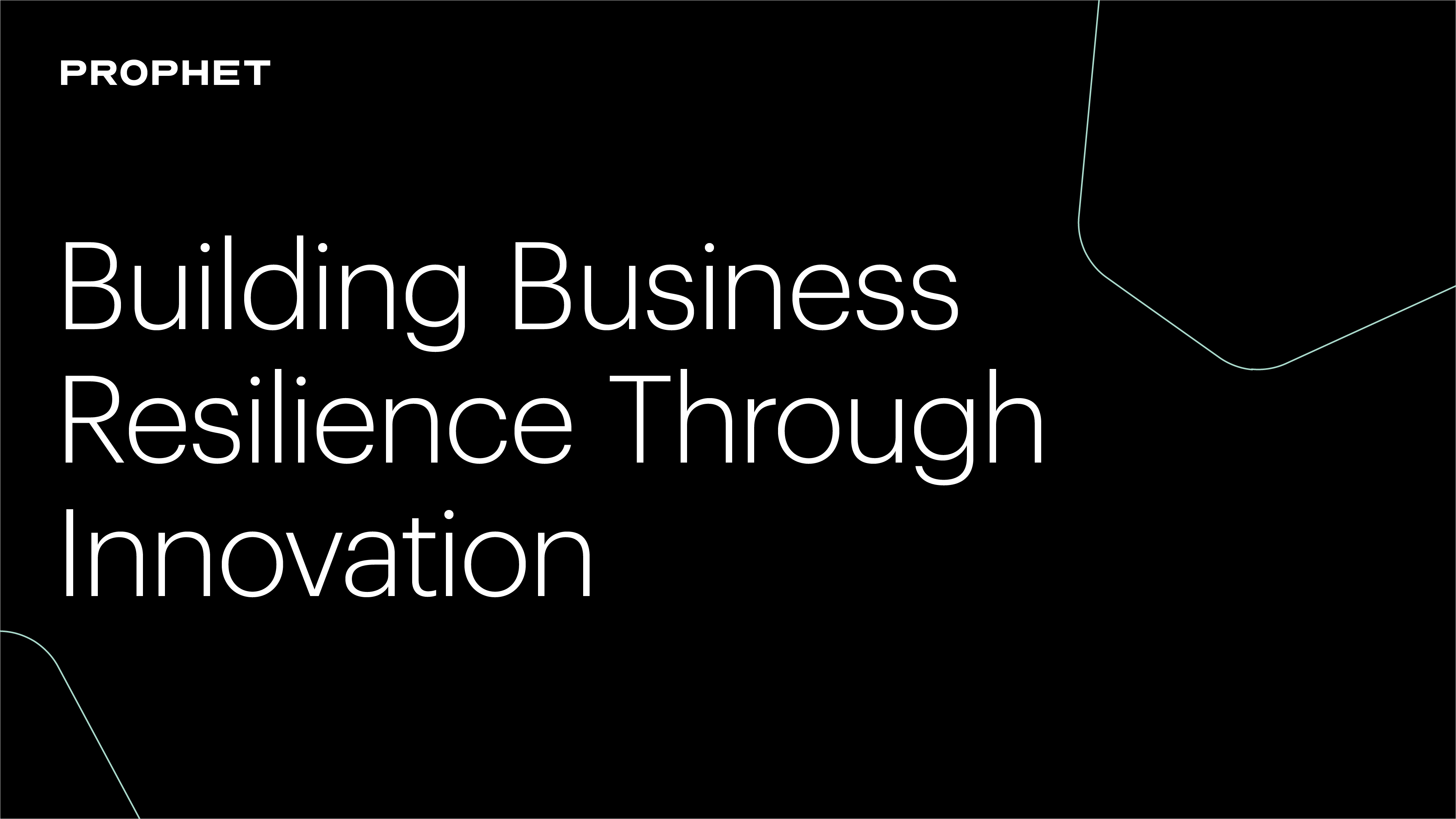BLOG
3 Ways to Out-Innovate the Downturn
Prioritizing innovation is key to unlocking sustainable growth – particularly in turbulent times – and enabling this requires a new level of collaboration.
Collaboration inspires innovation. It fuels growth and accelerates transformation. Yet with so many eyes focused on the turbulent economy, companies are losing sight of innovation’s value. As fear infuses corporate conversations, many are already using the uncertainty to justify putting innovation efforts on hold. They shift from finding new sources of growth to focusing on ways to shrink–what projects to mothball? Which budgets to cut? Which workers to eliminate?
That short-sightedness is a mistake. History has shown us, again and again, that companies that move into head-down defensiveness miss out on the rich opportunities that downturns create. Competitors change course. Customer behavior shifts. Old needs fade, and new ones arise.
Unless companies actively seek ways to boost innovation, collaborating throughout the organization to enrich new and better experiences, they’re missing out on transformative possibilities. Past recessions have given us innovative new companies and operating models, from the sharing economy to the crypto craze. And companies that look for new ways to grow, expand and transform consistently outperform the batten-down-the-hatches crowd.
It takes collaborative muscle. Our recent research shows that companies can systematically build that strength. And those that do are more productive, finding relevant solutions that aren’t just novel but also high-impact and potentially transformative.
Three places to begin right now are:
1. Prioritize Customer Journeys, Not Functions or Departments
Getting teams to work well beyond their silos isn’t a new problem. But it’s taken on outsized urgency as companies see themselves constantly out–flanked by category disruptors. Departmental boundaries serve a role but also thwart flexibility, speed and innovative potential. They slow transformation. And the bad news is that our research shows hybrid workplaces are even worse at collaborative efforts.
In most companies, people are still primarily evaluated and compensated on functional and departmental key performance indicators. Their work is often not even in alignment with organizational goals. Because there’s no formal or systematic recognition for interdepartmental teams, efforts fizzle out. In addition, customers continue to face disjointed products and services. They feel like they’re dealing with one brand in customer service or marketing but a completely different one in operations or sales.
Solving this problem doesn’t necessarily require sweeping organizational changes. Companies can move toward this type of change starting with small pods, giving them a clear focus and the agency to test and prove new collaborative models.
The more touchpoints and complexity a product or service contains, the more critical this step becomes. Prophet recently worked with a large purpose-driven financial services company, which wanted to provide better tools, programs and support for its financial advisors. It also wanted to ensure that each new offer and channel conveyed its purpose, whether it was a young family looking for a first insurance policy or older consumers focused on estate planning. Using a “pods and squads” model, we helped the company build small cross-functional teams focused on core customer needs. Viewing that work within the context of the company helped create a model that it could scale throughout the organization and overcome internal friction by finding a more seamless approach for advisors and end customers.
Where to Start:
Think small, with concrete and specific projects. While the ultimate goal might be to organize cross-functional teams for each segment of the company’s audience, individual pilots are more practical than ripping out all the plumbing. Create goals and objectives, restructuring KPIs around jobs to be done. This works by creating small wins, fueling the collaborative mindset.
2. Maximize Principles, Minimize Process
Truly collaborative organizations–not surprisingly, the most innovative–are powered by principles. It’s not that they don’t have rules and decision matrices to govern how work is done–they do. It’s just that they have overriding principles and values that are more important. These principles provide clarity and direction in ways process guidelines can’t.
Google’s 20% Project is one of the most famous examples and has led the company to such innovations as Gmail and Google Maps. Others have turned similar side-project principles into ventures like Slack and Twitter.
When principles guide companies, they become social norms–more potent than rule-based ways to make decisions. But there’s an art to settling on the correct principles. Too often, they’re vague, benign and become something tacked up on the office wall, like “Be nice” or “Listen to others.”
Fluffy platitudes aren’t enough – principles must provide enough depth and structure to feel relevant and contextual. They should inform people as they consider, “What’s right for this company? This brand? In this moment?” And they further a company’s purpose, emphasizing simplicity, adaptability and sustainability.
When there are rules, people cooperate. When there are principles, they collaborate–but they must find common ground between themselves, their colleagues and the company. Prophet’s Collaboration Flywheel Model™️ helps leaders and organizations move toward an environment that is sustainable and delivers more impactful outcomes faster over time
For example, our recent work with CVS Kidney Care focused on translating its “culture of courage” into innovations to help millions of people suffering from kidney disease. We established principles for how the group wanted to work as a team, how to communicate, and how to share information.
Our teams supported CVS Kidney Care in translating those goals into principles required to completely disrupt the kidney-care universe. Using two-week agile sprints to break down silos, we helped it focus on patient, caregiver and provider priorities. The result? A truly transformed experience for kidney patients, delivering personalized, seamless care with less time away from home and work–and improved health outcomes.
Where to Start:
Focus on team autonomy and team charters. Positioning these as the first steps in building team dynamics often makes a natural step to developing or redefining the Employee Value Proposition. The EVP can –and should –distill these ideas, connecting principles to brand promise. This kind of collaboration leads to EVPs that intersect beautifully with an organization’s overall purpose and each part of the company, from experience and innovation teams to brand and culture specialists.
3. Play with Prototypes, Not Presentations
If pictures are worth a thousand words, prototypes are worth a thousand user stories. People learn best by doing, so involving people throughout the organization in play sessions that let them roll up their sleeves will lead to more innovative and effective solutions than yet another 90-page PowerPoint. Embedding a maker mentality stimulates constructive conversation about new ideas, which are often hard to share and explain.
Put simply, doing uncovers more wisdom than thinking.
And yes, we get that it’s challenging to convince a C-suite focused on cutbacks and retrenching to step up their commitment to play. But it’s a crucial ingredient. Play opens people’s minds, facilitating new ways of thinking and doing. We often use Lego’s Serious Play in workshops to help people better connect their brains’ right and left sides. This co-creation opens collaborators’ minds, giving them a better sense of what is and isn’t possible.
Iteratively building–testing and playing in this way–gets organizations to more efficient learning and definition.
Adults aren’t good at it. The famous Spaghetti Marshmallow Tower is one of our favorite examples. When given a marshmallow, some dry spaghetti, tape and the instructions to build the tallest tower in 18 minutes, those with MBAs perform miserably. They assume there is a single best approach. They over-analyze. They jockey for power. As they run out of time, they realize their towers can’t support a marshmallow.
Those that do best? Kindergartners. Their sturdy towers are taller and more varied–precisely because they prototype every step of the way.
This playfulness solves another problem: Not all people in organizations perceive collaboration in the same way. Enthusiasm, and the perception of effectiveness and value of collaboration, vary by department and across regions. Why not make it more enjoyable?
We recently did a project for a healthcare company that wanted to extend its reach among small and mid-sized medical practices. These providers offer excellent care but often lack the marketing resources of large practices.
Before we started building things, we developed a series of interactive prototypes. Many people from departments as diverse as risk, compliance, finance and operations had the chance to play with the different options. They poked and prodded, turning solutions upside down.
When a roomful of people hears remarks like, “This approach is more engaging, but it would mean we’d have to change X or Y to implement it,” there’s less friction between departments–everyone can see why collaboration is better. It highlights what is most valuable to the end user and why.
Where to Start:
Rapid prototyping doesn’t have to be elaborate. It should begin with sketching on paper. It should be dirty, ugly and fun. Exercises like mash-up innovation, how-now-wow and bad-idea brainstorms can be light exercises to generate initial concepts. Service storyboards and mood boards help and so does writing a make-believe press release for a hypothetical launch. Anything that involves the team in different ways to communicate ideas is helpful.
Check out our most recent research – Building Business Resilience Through Innovation
FINAL THOUGHTS
Effective collaboration is essential in order to increase the pace and quality of innovation efforts across the organization. It is also one of the most meaningful aspects of employee engagement and personal growth. And that personal growth – learning new skills, extending networks and increased productivity – translates to the entire organization, helping enterprise goals to be achieved more quickly. In down markets, prioritizing collaboration gives companies an innovative advantage and delivers new and different sources of growth.

